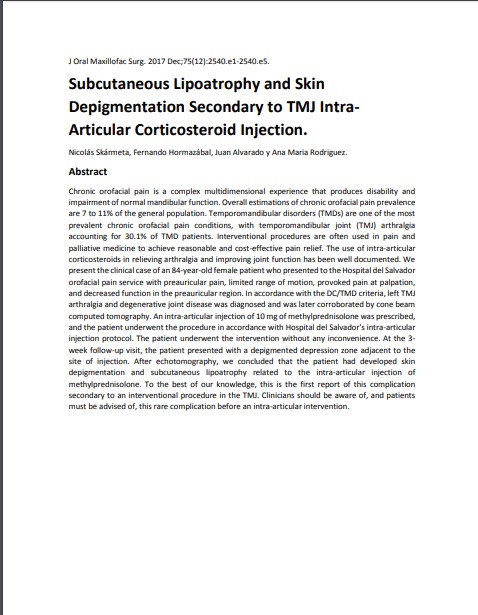Subcutaneous Lipoatrophy and Skin Depigmentation Secondary to TMJ Intra-Articular Corticosteroid Injection

Fecha
2017Autor
Skármeta N.P., Hormazábal F.A., Alvarado J.
Rodríguez, Ana María [Departamento de Radiología Maxilofacial, Universidad Mayor, Chile]
Ubicación geográfica
Notas
HERRAMIENTAS
Acceda a títulos restringidos
¿Cómo descargar?Resumen
Chronic orofacial pain is a complex multidimensional experience that produces disability and impairment of normal mandibular function. Overall estimations of chronic orofacial pain prevalence are 7 to 11% of the general population. Temporomandibular disorders (TMDs) are one of the most prevalent chronic orofacial pain conditions, with temporomandibular joint (TMJ) arthralgia accounting for 30.1% of TMD patients. Interventional procedures are often used in pain and palliative medicine to achieve reasonable and cost-effective pain relief. The use of intra-articular corticosteroids in relieving arthralgia and improving joint function has been well documented. We present the clinical case of an 84-year-old female patient who presented to the Hospital del Salvador orofacial pain service with preauricular pain, limited range of motion, provoked pain at palpation, and decreased function in the preauricular region. In accordance with the DC/TMD criteria, left TMJ arthralgia and degenerative joint disease was diagnosed and was later corroborated by cone beam computed tomography. An intra-articular injection of 10 mg of methylprednisolone was prescribed, and the patient underwent the procedure in accordance with Hospital del Salvador's intra-articular injection protocol. The patient underwent the intervention without any inconvenience. At the 3-week follow-up visit, the patient presented with a depigmented depression zone adjacent to the site of injection. After echotomography, we concluded that the patient had developed skin depigmentation and subcutaneous lipoatrophy related to the intra-articular injection of methylprednisolone. To the best of our knowledge, this is the first report of this complication secondary to an interventional procedure in the TMJ. Clinicians should be aware of, and patients must be advised of, this rare complication before an intra-articular intervention. (C) 2017 American Association of Oral and Maxillofacial Surgeons
URI
https://www.sciencedirect.com/science/article/pii/S0278239117310169https://doi.org/10.1016/j.joms.2017.07.174
https://www.joms.org/article/S0278-2391(17)31016-9/fulltext
http://repositorio.umayor.cl/xmlui/handle/sibum/6939
Coleccion/es a la/s que pertenece:
Si usted es autor(a) de este documento y NO desea que su publicación tenga acceso público en este repositorio, por favor complete el formulario aquí.